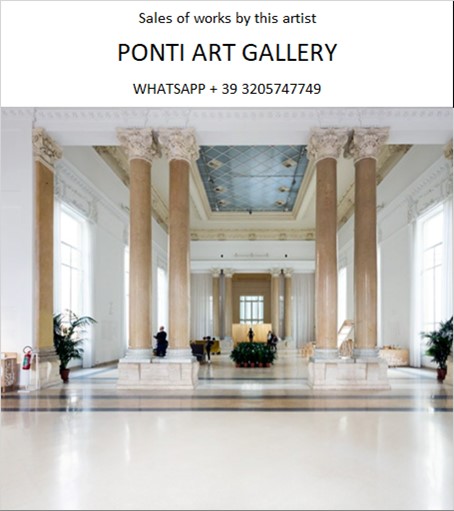Ponti Art Gallery is interested in buying and selling works
of art by this artist.

Ernst-Wilhelm Nay Biography
Ernst Wilhelm Nay was a pivotal figure in the evolution of modern art in Germany, whose work served as a bridge between the figurative expressionism of pre-war modernism and the gestural abstraction that followed. Born on June 11, 1902, in Berlin, Nay grew up in a civil servant's family and was the second of six children. His father, Johannes Nay, died as a captain in Belgium in 1914, which was a significant event in the young Nay's life. He completed his humanistic education with the Abitur at the provincial school Pforta in Thuringia in 1921, where he began to paint.
Nay's early artistic endeavors were self-taught, and he initially supported himself with odd jobs while painting self-portraits and landscapes. His talent was recognized when he presented himself in 1924 to Karl Hofer at the College of Fine Arts in Berlin with three of his autodidactic paintings. Hofer, impressed by Nay's skill, awarded him a scholarship and included him in his painting class. It was at the college where Nay met his future wife, Helene (Elly) Kirchner, who worked there as a model. He completed his studies in 1928 and embarked on a journey that would see him become one of the most renowned German artists of the 20th century.
Nay's early works were influenced by Henri Matisse and his teacher Karl Hofer, and he began to gain recognition among collectors, art historians, and critics. He was represented in important exhibitions and received first prizes, which helped him establish his reputation as a promising young artist. In 1930, Nay was awarded a scholarship for a stay on Bornholm, where he created the so-called "beach pictures." A year later, he received the Villa Massimo Fellowship in Rome from the Prussian Academy of Arts, where he developed small-format, surrealist-abstract images.
However, Nay's career faced significant challenges during the rise of National Socialism in Germany. His work was labeled as "degenerate art," and around ten of his works were confiscated from museum collections. Nay himself destroyed one of his own works for fear of reprisal. In need of money, he joined the army in 1939 and was posted to the Eastern front, followed by France. Despite the difficult circumstances, Nay continued to make art when he was off duty, painting at the studio of an amateur artist he befriended in France. His studio in Berlin was bombed during the air raids of the German capital.
After World War II, Nay's international career took off when he participated in the Venice Biennale in 1948 and the first-ever Documenta in Kassel. He was included in subsequent editions of Documenta and represented Germany at the Venice Biennale in 1956. His work during this period was characterized by a move towards abstraction, with a focus on color and form. Nay's "Disk Paintings" from the 1950s and his "Eye Paintings" from the 1960s are particularly celebrated for their dynamic compositions and bold use of color.
Nay's contributions to art were recognized with numerous awards, including the gold medal at the Italian Premio Lissone in 1953, the Lichtwark Prize in Hamburg in 1955, the Grand Prize of the State of North Rhine-Westphalia for Painting in 1956, and the Guggenheim Prize in New York in 1960. He was also a member of the Akademie der Künste in Berlin and was awarded the Great Cross of Merit of the Federal Republic of Germany.
Throughout his career, Nay was a prolific artist, and his work was exhibited in numerous solo and group exhibitions across Europe and the United States. His paintings are found in many prestigious museums, including the Nationalgalerie Berlin, Tate Modern in London, and the Solomon R. Guggenheim Museum in New York.
Ernst Wilhelm Nay passed away on April 8, 1968, in Cologne, leaving behind a legacy that continues to influence and inspire artists and art lovers around the world. His work remains a testament to his mastery of color and form and his significant role in the development of modern art in the post-war era.
Ernst-Wilhelm Nay Quotes and
Sales of Works
Ponti Art Gallery selects and deals with paintings by the
artist. Upon request, we provide free estimates and
evaluations, communicate prices, quotations, and current
market values.
If you are interested in BUYING or SELLING works by the
artist, contact us immediately.
If you wish to sell or receive an evaluation of the
works:
Send us a frontal photo of the painting, one of the back,
and one of the signature. Also, indicate the dimensions of
the work. Inform us about the purchase origin of the work
and any kind of available documentation (purchase
receipts, certificates of authenticity, publications). One
of our operators will respond to you on the same day. We
guarantee maximum confidentiality and extreme
professionalism.
If you wish to purchase works by the painter: Contact us
and let us know your request. We will inform you about the
available works. We also offer the possibility to
subscribe to our NEWSLETTER, through which you will be
informed at the beginning of each month about the latest
acquisitions of the art gallery.
You can send us pictures of the work:
